At-a-glance guide to infection control in day care
As the day-care population grows, so does the need to protect both children and staff from infectious diseases. This concise overview summarizes how different infections spread, who's at risk, and the policies and procedures needed to control infection without excluding children from day care unnecessarily.
At-a-glance guide to infection control in day care
By Leigh G. Donowitz, MD
As the day-care population grows, so does the need to protect both children and staff from infectious diseases. This concise overview summarizes how different infections spread, who's at risk, and the policies and procedures needed to control infection without excluding children from day care unnecessarily.
Around 15 million children under 5 years of age receive some of their care from child-care services. Looking at this another way, 90% of families with children younger than 5 years use child-care services of some kind. Infectious diseases among children in day care are common, significant, and costly.
Surveillance studies have documented that children in day care are at increased risk of otitis media, bronchiolitis, and gastroenteritis.14 Children under 2 years of age in child care have more than 60 days of illness and six or more respiratory infections per year.2 We also know that about 40% of parents' absenteeism from work results from illness in their children.5 Much of the absenteeism is caused by overly conservative exclusion policies of child-care providers.6 Many such policies require expensive and often unnecessary physician visits and antibiotics before a child is allowed to return to day care. Excessive antibiotic use among children in child care has been implicated as one of the leading causes of increasing antibiotic resistance.7
Pediatricians are in a position to help both families and day-care providers with these issues by promoting measures, such as vaccination, that reduce the spread of infection and encouraging infection control policies that protect children and day-care staff without imposing unnecessary burdens on parents. To that end, this article reviews the major elements of infection control in day-care settings.
Children in day care have a high incidence of infection for a variety of reasons:
- they are together in large numbers and in close contact with each other
- they lack a sense of personal hygiene
- many are not toilet trained
- they put everything in their mouths
- they are susceptible to most infectious agents
- they have a high incidence of viral infection
- they may be contagious before they are symptomatic (as with parvovirus B19 and varicella) and may be asymptomatic during the infection (as with Giardia and hepatitis A).
Employees at risk
High-risk day-care employees are those who are susceptible to childhood illnesses or are immunocompromised. Child-care workers who have no immunity to the usual childhood illnesses (such as measles, mumps, and chickenpox), either because they have never had the natural infection or were never immunized, place themselves at increased risk in the day-care environment. Persons who are susceptible to vaccine-preventable infections should be immunized prior to employment.
Day-care staff who are pregnant or immunocompromised, or have other underlying medical conditions (asplenia, cancer, transplantation, HIV infection) that place them at high risk for becoming infected or developing a more severe illness when they are infected need to understand the risks that their condition or therapies present. They must consult their physicians about the specific risks they face and take appropriate precautions (immunizations, infection control techniques, barrier precautions, furlough during epidemics) to minimize the risks.
Children at risk of infection
Young infants in day care have a higher-than-average risk of becoming infected or developing a severe illness when they are infected, as do children with immunodeficiencies, chronic lung disease, cardiac disease, disabilities, and chronic skin disease. Young infants and immunodeficient children are susceptible to most pathogens as well as many organisms considered to be nonpathogenic in the normal child.
Children with chronic lung and cardiac disease and some children with disabilities can develop severe and even life-threatening illness when infected with common respiratory viral infections. Children with chronic skin diseases, such as eczema, may not localize certain cutaneous infections such as herpes simplex virus and streptococcal and staphylococcal infections. The infection may become widespread in the skin or invasive. Parents need to fully understand their child's medical condition, see that appropriate precautions are taken, and plan for alternate day care when pathogens of concern to their child are present in the center.
Children at risk of spreading infection
Children who are infected or colonized for prolonged periods are at high risk of spreading infection in the crowded, susceptible day-care population. They include:
- children living in impoverished conditions, including those who have multiple caregivers, live in transient "families" or shelters, or live in conditions where sanitary conditions are poor
- children living in homes where persons with untreated or chronic infections are present
- children from developing nations
- children with immunodeficiencies
- children with chronic infections.
Such children need to be examined prior to enrollment in day care and reexamined whenever child-care staff suspect infection.
Means of transmission
Pathogens are transmitted among children in day care and between children and staff by contact with infected respiratory secretions, feces, skin or mucous membranes, fomites, and blood and body fluids. Respiratory transmission spreads pathogens by large- or small-particle aerosolization or direct or indirect contact with infected respiratory secretions. Fecal-oral transmission spreads pathogens by direct or indirect inoculation of gastrointestinal pathogens into the mouth of the susceptible recipient.
Transmission by skin or mucous membrane contact includes spread of pathogens by direct touch or indirectly via a contaminated environmental surface or object. Blood and body fluid transmission occurs when infected blood or body fluids enter the body via a bite or needlestick or are splashed or splattered onto nonintact skin or mucous membranes. Tables 1 through 4 list the pathogens spread by each of these means.
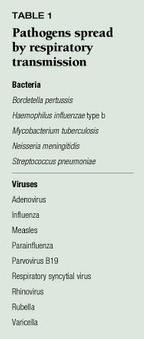
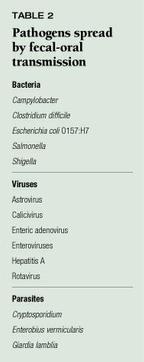

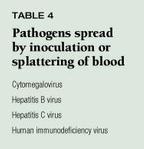
Preventive strategies
Strategies for preventing and managing infectious diseases in day-care facilities are modeled on those used in medical settings. All employees should understand and use standard precautions, as outlined by the Occupational Safety and Health Administration (OSHA) (Table 5). These precautions apply to all employees who "as a result of their duties, could have skin, eye, mucous membrane, or parenteral contact with blood or other potentially infectious material," including all body fluids, secretions, and excretions except sweat, regardless of whether or not they contain visible blood.8
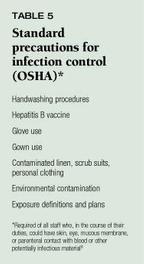
Day-care centers should know the medical histories of children and staff so as to protect them by exclusion or job change when pathogens dangerous to high-risk individuals are present in the facility. Centers should also enforce immunization recommendations and requirements for vaccine-preventable infections for both children and staff (Table 6).
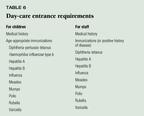
The center needs standards for number of staff, housekeeping procedures, continuing infection control education, and division of labor such that food preparers are not diapering infants. Handwashing, diapering, and food preparation goals and procedures are essential to preventing the spread of infection. Table 7 outlines these procedures.
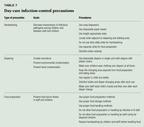
Day-care centers must develop reasonable guidelines for excluding children with serious or highly contagious infections and strict guidelines for excluding high-risk children when pathogens hazardous to their health are present. Exclusion policies should be designed to eliminate known high-risk pathogenssuch as meningococcus, pertussis, and tuberculosisbut not routine viral illness, such as a cold or ear infection, that does not cause fever or limit the ability of the child to participate in normal activities. They should be understood by parents, child-care providers, local public health authorities, and health-care providers. Table 8 lists criteria for readmitting children with some common infections to day care. Parents should be instructed in ways to prevent infection (vaccination, infection control measures) and should have alternative child-care plans for illnesses that do require exclusion.
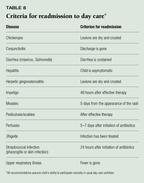
Using state and local standards and pediatric and child-care literature, day-care administrators and health-care providers need to develop policies that do not limit attendance for mild viral illness, do not promote the inappropriate use of antibiotics and thus antibiotic resistance, yet maintain strict admission standards, effective exclusion policies for children with high-risk infections and, most important, high standards of infection control at all times.911
THE AUTHOR is Professor of Pediatrics at the University of Virginia School of Medicine, Charlottesville.
REFERENCES
1. Wald ER, Dashefsky B, Byers C, et al: Frequency and severity of infections in day care. J Pediatr 1988;112:540
2. Wald ER, Guerra N, Byers C: Frequency and severity of infections in day care: Three-year follow-up. J Pediatr 1991;118:509
3. Loubiala PJ, Jaakkola N, Ruotsalainen R, et al: Day-care centers and diarrhea: A public health perspective. J Pediatr 1997;131:476
4. Cordell RL, MacDonald JK, Solomon SL, et al: Illness and absence due to illness among children attending child-care facilities in SeattleKing County, Washington. Pediatrics 1997;100:850
5. Bell DM, Gleiber DW, Mercer AA, et al: Illness associated with child day care: A study of incidence and cost. Am J Public Health 1989;79:479
6. Shapiro ED, Kuritsky J, Potter J: Policies for the exclusion of ill children from group day care: An unresolved dilemma. Rev Infect Dis 1986;8(4):622
7. Holmes SJ, Morrow AL, Pickering LK: Child-care practices: Effects of social change on the epidemiology of infectious diseases and antibiotic resistance. Epidemiol Rev 1996;18(1):10
8. US Department of Labor, Occupational Safety and Health Administration: Occupational exposure to blood-borne pathogens, final rule. CFT part 1910.1030. Federal Register 1991;56:64004
9. American Public Health Association, American Academy of Pediatrics: Caring for Our Children. National Health and Safety Performance Standards: Guidelines for Out-of-Home Child Care Programs. Washington, DC, American Public Health Association, 1992, pp 65114
10. American Academy of Pediatrics, Committee on Infectious Diseases: Children in out-of-home child care, in Peter G (ed): 1997 Red Book: Report of the Committee on Infectious Diseases, ed 24. Elk Grove Village, IL, American Academy of Pediatrics, 1997, pp 8393
11. Donowitz LG (ed): Infection Control in the Child Care Center and Preschool, ed 3. Baltimore, Williams and Wilkins, 1996
Leigh Donowitz. At-a-glance guide to infection control in day care. Contemporary Pediatrics 1999;11:127.